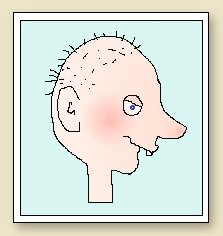|
Pinyin vs. Wade-Giles
Pinyin Man . Meet Pinyin Man.......not to be confused with the ancient Neanderthal Man, but similar. Related to the monkey only by the fact he has tossed a monkey-wrench into the English / Latin Romanization of the Chinese language.This is a very controversial subject. In case the reader is not familiar with the terms Pinyin or Wade-Giles, they are the two most popular forms of Romanization used in transcribing Chinese to English. You may have noticed that there seem to be different manners of spelling when researching either an emperor's name or, for that fact, any Chinese word. This is especially noticeable on the Internet. Here's an example using the Pinyin spelling "Qing" and the Wade-Giles equivalent spelling "Ch'ing" for the name given the Chinese dynasty that ruled from the year 1644 to 1912. Googling the Pinyin spelling "Qing dynasty" returns about 10,000,000 results. Googling the Wade-Giles equivalent spelling "Ch'ing dynasty" returns only about 100 results. This explains why I occasionally run into someone, usually a younger person, that says "Oh ..... it's Qing." pronounced with a "Q" sound. I politely correct them, saying it's pronounced with the "Ch" sound, not the "Q" sound.
Another example is when comparing Pinyin
with the Wade-Giles spelling and pronunciation of the great Ming
emperor Xuande (Pinyin). Pinyin uses the "X" for the "Hs" sound, and a "D" for the "T" sound, and the hyphen is removed. The name is now seen as one word, Xuande. It drives me crazy when I watch the Antiques Roadshow and the 'expert' says "What we have here is a zooo-annnn-deee piece." Ask any Chinese person the correct pronunciation and you will get it pronounced (with the "H" being mostly silent) 'suan-tē ', two separate one-syllable words. The Chinese must think we are crazy. Working with a simple proper name correctly pronounced as two separate single syllable words, we take the "Hs" sound and pronounce it with the "Z" sound, yet we spell it with an "X" as one word. We then incorrectly pronounce it with three syllables. Then we talk of zooo-annnn-deee with all our vast knowledge as if we knew him. I do understand the need for universally accepted transliteration, especially now with the Internet. The problem is that most of the English written history regarding Chinese history was written using the Wade-Giles Romanization which had been in existence since 1859. The proper use of the apostrophe, however, was somehow lost over the years in the Wade-Giles Romanization. This caused many problems in transliteration. It wasn't until the year 2000 that the Library of Congress officially joined the rest of the world in accepting Pinyin Romanization as Universal. Being from
the old school, I still prefer Wade-Giles when it comes to spelling and
pronunciation. However, to keep up with the changing times,
I've slowly been converting my site to Pinyin since I have many Chinese
viewers. This alone creates some new challenges, but now
related to the computer. There are two main character sets
used when translating English to Chinese, and vice-versa.
They are referred to as Simplified Chinese, and
Traditional Chinese. Unless your computer is set up properly
to view Chinese fonts, you will get a page full if either ? (question
marks) or I hope this information is helpful in explaining the difficulties you may encounter in researching any Chinese subject in either English or Chinese. JP
|
